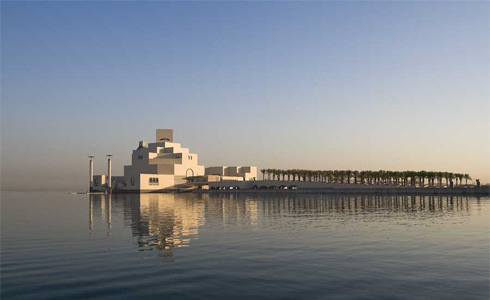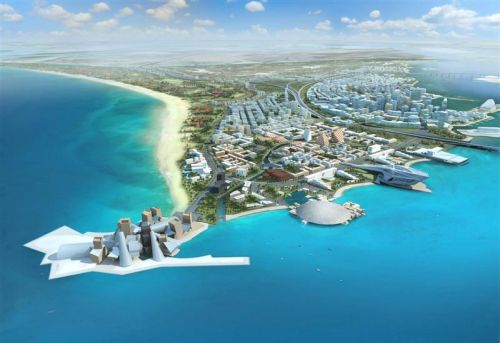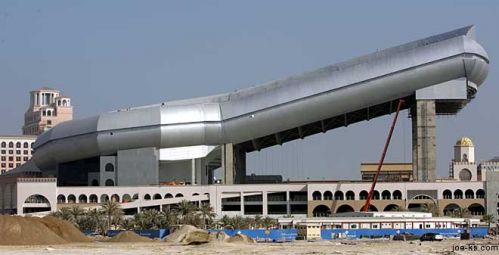theartsdesk in the Emirates: A Cultural Arms Race | reviews, news & interviews
theartsdesk in the Emirates: A Cultural Arms Race
theartsdesk in the Emirates: A Cultural Arms Race
The cultural arms race in the Gulf hots up
Rising spectacularly from the warm turquoise waters of Doha Bay, the building which is probably I.M. Pei’s final and perhaps his greatest work, the iconic Museum of Islamic Art, symbolises the cultural arms race among the Islamic Emirates strung out along the Gulf, on the flank of Big Brother Saudi Arabia.
Pei, now 92, journeyed through the Muslim world in search of the inspiration to be able to reflect its artistic traditions. The result is an austere cubist design - the crowning level a minimalist limestone version of a woman’s veiled face that catches the changing light of the sun. On Doha’s graceful parkland Corniche, it houses one of the world’s largest and finest collections in a series of spaces ranging from the intimate to the spaciously grand.
Pei was called out of retirement to create the Museum of Islamic Art as the signature piece of an ambitious and expensive program to establish oil-and-gas-rich Qatar as one of the pre-eminent arts and culture centres in the world. His work was undoubtedly the tipping point which emboldened the New York Times to declare Qatar the top cultural destination of 2008.
Not so long ago, the Gulf Emirates were a series of strategically important but barren and hostile outposts on the Arabian peninsula living on pearls and piracy and the centre of rivalry between the Ottomans and the British. Now, flush with petrodollars and largely immune to the financial crisis sweeping the world (despite last week's news about Dubai's crippling debts), they are spending tens of billions of dollars buying in the best arts, culture and entertainment from around the world, snapping up “franchises” such as a Louvre and a Guggenheim for Abu Dhabi and a Tribeca Film Festival in Qatar.
 The irony is Dubai, the extravagant high-flyer of the United Arab Emirates (UAE) that gambled on a glass-and-marble mix of Las Vegas glitz and theme parks rather than culture, is now on the brink of the biggest sovereign debt meltdown since Argentina, despite efforts by Dubai to distance itself from its own investment arm.
The irony is Dubai, the extravagant high-flyer of the United Arab Emirates (UAE) that gambled on a glass-and-marble mix of Las Vegas glitz and theme parks rather than culture, is now on the brink of the biggest sovereign debt meltdown since Argentina, despite efforts by Dubai to distance itself from its own investment arm.
Abu Dhabi, the richest of the seven UAE sheikhdoms and sitting on top of some of the biggest oil and gas resources in the world, has pledged to step in to help Dubai, calming financial markets and creditors. More financially and religiously conservative than Dubai, Abu Dhabi has the reserves to bail out a family member and still continue its own plans to stamp its mark on the world.
Doha’s Museum of Islamic Arts (picture right)– for which Pei asked the royal family to create a finely manicured artificial island of rich green lawns and palm trees as a quarantine from any unsightly future development along the Corniche – is the most prominent sign of success. But there are still tens of billions of dollars of investment in the pipeline among Bahrain, Qatar and the seven sheikhdoms of the United Arab Emirates (UAE).
A few years ago Saadiyat Island, “the Island of Happiness”, was just a low-lying 27 square kilometres of sand, palm-fringed beaches, wetlands and mangroves just 500 metres off the waterfront of Abu Dhabi – the capital of the United Arab Emirates (UAE) and its largest and richest emirate. It’s now a frantic $27 billion construction site of dust and noise and activity that Abu Dhabi hopes will become a world showpiece.
Some of the world’s biggest names have been lured to create innovative, exciting buildings to fit the island’s desert-on-water location: Jean Nouvel for the Louvre; Frank Gehry for the Guggenheim; Norman Foster for the Zayed National Museum and Zaha Hadid for the Performing Arts Centre. Abu Dhabi arts and tourism authorities are running a series of exhibitions of leading international works to increase attention on Saadiyat. These will rapidly step up, as will “teaser” exhibits oveseas, ahead of the museums’ planned opening in 2013.
 The Cultural District on Saadiyat’s northwestern tip (computer-generated model, picture left) is only a small patch of what one international newspaper has dubbed “Art Island” but it is the centerpiece of Abu Dhabi’s campaign for prestige, a name in the global art world and to attract high-end tourists. When it is finished in 2020, Happiness Island expects 160,000 residents to be living among the luxury marinas, residential developments and resorts and hotels.
The Cultural District on Saadiyat’s northwestern tip (computer-generated model, picture left) is only a small patch of what one international newspaper has dubbed “Art Island” but it is the centerpiece of Abu Dhabi’s campaign for prestige, a name in the global art world and to attract high-end tourists. When it is finished in 2020, Happiness Island expects 160,000 residents to be living among the luxury marinas, residential developments and resorts and hotels.
Rivalry between Bahrain, Qatar and the seven emirates of the United Arab Emirates, which includes Dubai, has been intense for centuries. But since the discovery of oil in the region in the 1930s, it has focused more and more on becoming a global financial centre, luring tourists and attracting foreign investment, industry and US military bases. Also at stake is pride and face. Each wants to prove itself and win international recognition. The various royal families have personally weighed their names and their money. In many ways, arts and entertainment has become the new battleground, with Abu Dhabi and Qatar taking the lead. As well as the physical resources, all the Gulf states are spending a lot of money on top-level talent: everyone from Robert De Niro to Tiger Woods, Beyonce to Yo-Yo Ma, Aerosmith and beyond.
 But to drive around any of the Emirates can be a jolting experience. The masterpieces of Pei, Gehry, Hadid and others jar with both the glass pyramid shopping malls and indoor ski-slopes (picture right) of Dubai and the region’s plywood shacks of official labour camps – you can even buy one under “labour camps” in the newspaper classifieds – for the other “talent” that has to be bought in: the Indians, Pakistanis, Bangladeshis and Sri Lankans that build the skyscrapers and the roads and man the busy ports.
But to drive around any of the Emirates can be a jolting experience. The masterpieces of Pei, Gehry, Hadid and others jar with both the glass pyramid shopping malls and indoor ski-slopes (picture right) of Dubai and the region’s plywood shacks of official labour camps – you can even buy one under “labour camps” in the newspaper classifieds – for the other “talent” that has to be bought in: the Indians, Pakistanis, Bangladeshis and Sri Lankans that build the skyscrapers and the roads and man the busy ports.
Critics from the Middle East and around the world do point out money doesn’t buy everything. Although generally only spoken of quietly and carefully, there are concerns over creativity and censorship and the way some of the funding and acquisitions have sometimes been handled in a region where tribe and family can trump transparency. At least one major project in the region has been significantly delayed by concerns over the way its acquisitions and spending have been handled by well-connected local executives.
"You can have all the money and resources at your disposal, but that doesn't create art,” says award-winning Iranian filmmaker Abbas Kiarostami, who headed the jury at Abu Dhabi’s recent Middle East International Film Festival. His remarks evoked memories of Singapore’s campaign a few years back to make its citizens more creative. Nudity and the use of certain religious symbols or portrayals are an obvious problem. But there is also a large, and ever-shifting, area of grey in the middle. For countries seeking to claim a place as the artistic crossroads of civilisation and culture, there are unanswered questions. Should art celebrate only religion? Can art be for art’s sake?
While all these projects have the support - sometimes paid, sometimes collaborative, sometimes both - from leading museums, galleries and other institutions around the world, there is no getting away from the fact that they are trying almost overnight to create entire collections and reputations that have taken others centuries to achieve.
Saadiyat Island on video:
{dmotion}x73n6p{/dmotion}
Add comment
more Visual arts
 Stephen review - a breathtakingly good first feature by a multi-media artist
Melanie Manchot's debut is strikingly intelligent and compelling
Stephen review - a breathtakingly good first feature by a multi-media artist
Melanie Manchot's debut is strikingly intelligent and compelling
 Fantastic Machine review - photography's story from one camera to 45 billion
Love it or hate it, the photographic image has ensnared us all
Fantastic Machine review - photography's story from one camera to 45 billion
Love it or hate it, the photographic image has ensnared us all
 Yinka Shonibare: Suspended States, Serpentine Gallery review - pure delight
Weighty subject matter treated with the lightest of touch
Yinka Shonibare: Suspended States, Serpentine Gallery review - pure delight
Weighty subject matter treated with the lightest of touch
 Jane Harris: Ellipse, Frac Nouvelle-Aquitaine MÉCA, Bordeaux review - ovals to the fore
Persistence and conviction in the works of the late English painter
Jane Harris: Ellipse, Frac Nouvelle-Aquitaine MÉCA, Bordeaux review - ovals to the fore
Persistence and conviction in the works of the late English painter
 Sargent and Fashion, Tate Britain review - portraiture as a performance
London’s elite posing dressed up to the nines
Sargent and Fashion, Tate Britain review - portraiture as a performance
London’s elite posing dressed up to the nines
 Zineb Sedira: Dreams Have No Titles, Whitechapel Gallery review - a disorientating mix of fact and fiction
An exhibition that begs the question 'What and where is home?'
Zineb Sedira: Dreams Have No Titles, Whitechapel Gallery review - a disorientating mix of fact and fiction
An exhibition that begs the question 'What and where is home?'
 Yoko Ono: Music of the Mind, Tate Modern review - a fitting celebration of the early years
Acknowledgement as a major avant garde artist comes at 90
Yoko Ono: Music of the Mind, Tate Modern review - a fitting celebration of the early years
Acknowledgement as a major avant garde artist comes at 90
 Unravel: The Power and Politics of Textiles in Art, Barbican review - the fabric of dissent
An ambitious exploration of a neglected medium
Unravel: The Power and Politics of Textiles in Art, Barbican review - the fabric of dissent
An ambitious exploration of a neglected medium
 When Forms Come Alive, Hayward Gallery review - how to reduce good art to family fun
Seriously good sculptures presented as little more than playthings or jokes
When Forms Come Alive, Hayward Gallery review - how to reduce good art to family fun
Seriously good sculptures presented as little more than playthings or jokes
 Entangled Pasts 1768-now, Royal Academy review - an institution exploring its racist past
After a long, slow journey from invisibility to agency, black people finally get a look in
Entangled Pasts 1768-now, Royal Academy review - an institution exploring its racist past
After a long, slow journey from invisibility to agency, black people finally get a look in
 Barbara Kruger, Serpentine Gallery review - clever, funny and chilling installations
Exploring the lies, deceptions and hyperbole used to cajole, bully and manipulate us
Barbara Kruger, Serpentine Gallery review - clever, funny and chilling installations
Exploring the lies, deceptions and hyperbole used to cajole, bully and manipulate us
 Richard Dorment: Warhol After Warhol review - beyond criticism
A venerable art critic reflects on the darkest hearts of our aesthetic market
Richard Dorment: Warhol After Warhol review - beyond criticism
A venerable art critic reflects on the darkest hearts of our aesthetic market

Comments
...